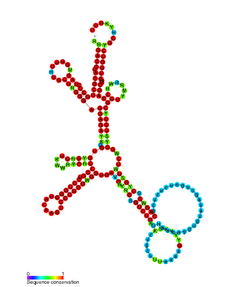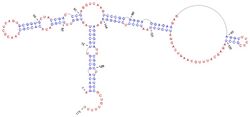Biology:Epstein–Barr virus–encoded small RNAs
| EBER1 | |
|---|---|
 Conserved secondary structure of EBER1. | |
| Identifiers | |
| Symbol | EBER1 |
| Rfam | RF01789 |
| Other data | |
| RNA type | Gene |
| Domain(s) | Epstein–Barr virus |
| PDB structures | PDBe |
The Epstein–Barr virus–encoded small RNAs (EBERs) are small non-coding RNAs localized in the nucleus of human cells infected with Epstein–Barr virus (EBV). First discovered in 1981, EBERs are the most abundant RNAs present in infected cells.[1] EBERs interact with several host proteins to form ribonucleoprotein (RNP) complexes. Although a precise function for EBERs remains elusive, roles in transformation and oncogenesis are proposed.
Background
EBER1 and EBER2 are short, 167 and 172 nucleotides in length respectively, nuclear-enriched non-coding RNAs. These two RNAs are transcribed by the host's RNA polymerase III during latent infection of EBV.[2][3]
EBERs 1 and 2 can be deleted from the viral genome without noticeable phenotypic changes, though this has never been found deleted in nature.[2] EBER expression alone can induce tumours in severe combined immunodeficient mice.[4][5]
EBER1
EBER1 associates with human ribosomal protein L22[6] and causes this protein to move from the nucleolus to the nucleoplasm.[7] EBER1 also specifically interacts with at least three host hnRNPs (A1, A2/B1 and D/AUF1).[8]
EBER2

Similar to EBER1, EBER2 is very highly expressed in latently infected cells. Unlike EBER1, the sequence of EBER2 is less conserved in related herpesviruses (~50% conservation). However, the secondary structure of EBER2 is highly conserved (see Figure 1). EBER2 is only known to bind cellular proteins (specifically, the La domain) at its terminal stretch of repeated uridines; however, it is believed that the other features of EBER2, particularly its two long and highly conserved stem-loops, may also serve as binding sites for yet unknown proteins.[9]
Richard Ambinder pioneered the application of EBER in situ hybridisation to the detection of Epstein-Barr Virus in clinical specimens in 1990.[10] The abundance of EBER targets in cells with latent EBV infection cells and ease of non-isotopic methodology in formalin-fixed paraffin wax embedded tissue sections made EBER in situ hybridisation eminently suited to clinical practice.[11] EBER detection has become an integral component of routine diagnostic histopathology.[12]
References
- ↑ "Two small RNAs encoded by Epstein-Barr virus and complexed with protein are precipitated by antibodies from patients with systemic lupus erythematosus". Proceedings of the National Academy of Sciences of the United States of America 78 (2): 805–809. February 1981. doi:10.1073/pnas.78.2.805. PMID 6262773.
- ↑ 2.0 2.1 "The challenge of viral snRNPs". Cold Spring Harbor Symposia on Quantitative Biology 71: 377–384. 2006. doi:10.1101/sqb.2006.71.057. PMID 17381320.
- ↑ "RNA families in Epstein-Barr virus". RNA Biology 11 (1): 10–17. 2014. doi:10.4161/rna.27488. PMID 24441309.
- ↑ "Oncogenic role of Epstein-Barr virus-encoded RNAs in Burkitt's lymphoma cell line Akata". Journal of Virology 73 (12): 9827–9831. December 1999. doi:10.1128/JVI.73.12.9827-9831.1999. PMID 10559294.
- ↑ "Malignant transformation of B lymphoma cell line BJAB by Epstein-Barr virus-encoded small RNAs". FEBS Letters 484 (2): 153–158. November 2000. doi:10.1016/S0014-5793(00)02145-1. PMID 11068051.
- ↑ "Multiple domains of EBER 1, an Epstein-Barr virus noncoding RNA, recruit human ribosomal protein L22". RNA 12 (5): 872–882. May 2006. doi:10.1261/rna.2339606. PMID 16556938.
- ↑ "The Epstein-Barr virus (EBV) small RNA EBER1 binds and relocalizes ribosomal protein L22 in EBV-infected human B lymphocytes". Proceedings of the National Academy of Sciences of the United States of America 91 (8): 3463–3467. April 1994. doi:10.1073/pnas.91.8.3463. PMID 8159770.
- ↑ "AUF1/hnRNP D is a novel protein partner of the EBER1 noncoding RNA of Epstein-Barr virus". RNA 18 (11): 2073–2082. November 2012. doi:10.1261/rna.034900.112. PMID 23012480.
- ↑ "RNA families in Epstein-Barr virus". RNA Biology 11 (1): 10–17. 20 Dec 2013. doi:10.4161/rna.27488. PMID 24441309.
- ↑ Wu, Tzyy-Choou; Mann, Risa B.; Charache, Patricia; Hayward, S. Diane; Staal, Steve; Lambe, Beverly C.; Ambinder, Richard F. (1990-11-15). "Detection of ebv gene expression in reed-sternberg cells of Hodgkin's disease" (in en). International Journal of Cancer 46 (5): 801–804. doi:10.1002/ijc.2910460509. PMID 2172169. https://onlinelibrary.wiley.com/doi/10.1002/ijc.2910460509.
- ↑ Barletta, Janet M.; Kingma, Douglas W.; Ling, Yun; Charache, Patricia; Mann, Risa B.; Ambinder, Richard F. (April 1993). "Rapid in situ hybridization for the diagnosis of latent Epstein-Barr virus infection" (in en). Molecular and Cellular Probes 7 (2): 105–109. doi:10.1006/mcpr.1993.1014. PMID 8391639.
- ↑ Weiss LM, Chen YY. EBER in situ hybridization for Epstein-Barr virus. Methods Mol Biol. 2013;999:223-30. doi: 10.1007/978-1-62703-357-2_16. PMID 23666702.
External links
- Page for Human herpesvirus 1 small nucleolar RNA at Rfam
- Page for EBER1 at Rfam
- Page for v-snoRNA1 at Rfam
- Page for IRES_EBNA at Rfam
- Epstein–Barr virus stable intronic sequence RNAs
 |
